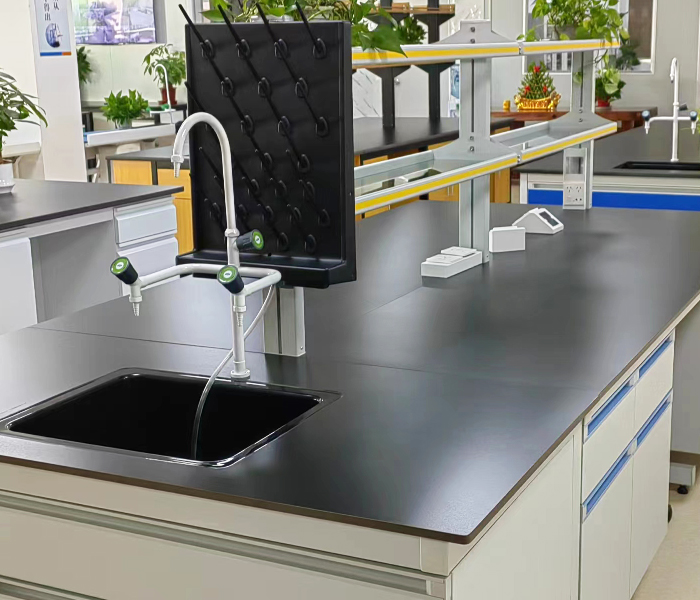Table of Contents
When designing a laboratory, choosing the right furniture is crucial, especially in environments where moisture, humidity, and liquids are constant concerns. Whether it’s a marine biology lab, chemistry lab, or any facility dealing with high moisture levels, water-resistant lab furniture plays a vital role in ensuring the safety, longevity, and effectiveness of the workspace. In this article, we’ll explore why water-resistant lab furniture is necessary, the best materials for moisture resistance, and how to protect your investment from mold, rust, or water damage.
Why Water-Resistant Lab Furniture is Essential
In labs where liquids and moisture are part of everyday operations, having water-resistant furniture isn’t just an option—it’s a necessity. For instance, marine biology labs often deal with saltwater, which can quickly degrade materials that are not moisture-resistant. Similarly, chemistry labs frequently handle corrosive chemicals that can damage surfaces over time if the furniture isn’t adequately protected. Moisture can cause significant damage if left unchecked, leading to mold growth, rust, warping, or surface deterioration.
For these environments, lab furniture must be specifically designed to withstand constant exposure to humidity and liquid spills. Investing in water-resistant lab furniture minimizes maintenance needs, enhances safety, and ensures that the furniture remains functional over a long period, even under challenging conditions.
Best Materials for Water-Resistant Lab Furniture
To create a lab environment that can resist the wear and tear caused by humidity, it’s important to choose the right materials. Below are some of the most effective moisture-resistant materials for lab furniture:
Polypropylene (PP)
Polypropylene is an extremely popular material for lab furniture in high-humidity environments. PP is non-reactive to most chemicals and completely resistant to water and moisture. It does not corrode, rust, or absorb moisture, making it ideal for furniture in labs that handle liquids frequently. It is also lightweight and durable, which adds to its long-term value.
Stainless Steel
Stainless steel is another excellent option for lab furniture in humid settings. Known for its durability and resistance to rust, stainless steel is a top choice in marine labs, wet labs, and facilities that deal with chemicals. It is easy to clean, corrosion-resistant, and can withstand exposure to liquids without the risk of water damage. Additionally, stainless steel can maintain its structural integrity and appearance over many years, even in challenging environments.
Phenolic Resin
Phenolic resin surfaces are incredibly moisture-resistant, durable, and can withstand exposure to harsh chemicals. These surfaces are often used for countertops and workstations in labs where spills are common. Phenolic resin is not only water-resistant but also heat-resistant, making it a versatile material for labs with diverse requirements. It does not warp or deteriorate when exposed to moisture, making it a wise choice for long-lasting lab furniture.
How to Prevent Mold, Rust, and Water Damage to Lab Furniture
Even with the right materials, it’s essential to take additional steps to prevent mold, rust, or water damage to your lab furniture. Below are a few tips for maintaining a moisture-resistant lab environment:
Regular Maintenance
Regularly cleaning and maintaining lab surfaces is essential to prevent mold and rust from developing. Ensure all spills are wiped up immediately, and use appropriate cleaning agents that do not compromise the protective coatings on your furniture.
Proper Ventilation
High-humidity environments require proper ventilation to reduce the risk of mold growth. Investing in dehumidifiers or efficient ventilation systems will help maintain lower moisture levels and protect your lab furniture from long-term damage.
Avoid Standing Water
Make sure that your lab design incorporates effective drainage and avoids areas where water can pool. Standing water can lead to quicker corrosion and the development of mold, so it’s important to eliminate it as soon as it appears.
Invest in Protective Coatings
For surfaces that are exposed to moisture but may not be inherently water-resistant, investing in moisture-resistant coatings can add an extra layer of protection. These coatings prevent water from penetrating surfaces and can extend the lifespan of your lab furniture.
Long-Term Benefits of Investing in Water-Resistant Lab Furniture
While water-resistant lab furniture may require a higher initial investment, the long-term benefits far outweigh the costs. Water damage can lead to costly repairs, frequent replacements, and interruptions in lab operations. By investing in moisture-resistant solutions from the outset, you ensure the durability and safety of your lab environment, while also reducing ongoing maintenance costs.
Moreover, water-resistant furniture contributes to a healthier work environment. The risk of mold, which can have serious health implications for lab workers, is significantly reduced. Similarly, corrosion-resistant materials like stainless steel minimize the risk of equipment failure and contamination due to rust particles.
Conclusion
Water-resistant lab furniture is essential for any laboratory dealing with liquids or high humidity. The right materials—such as polypropylene, stainless steel, and phenolic resin—can protect against moisture, rust, and mold, ensuring your lab remains functional and safe for years to come. Regular maintenance and proper ventilation are also key to prolonging the life of your lab furniture. Investing in moisture-resistant lab furniture today can save you significant time, money, and effort in the future.




